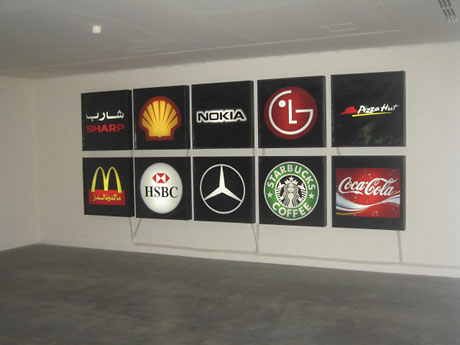
New Identity
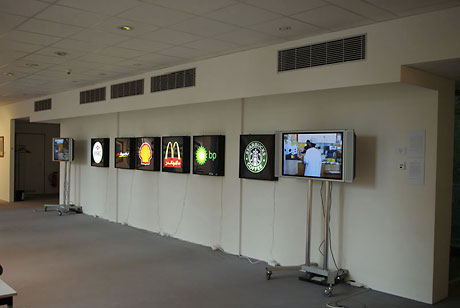
New Identity
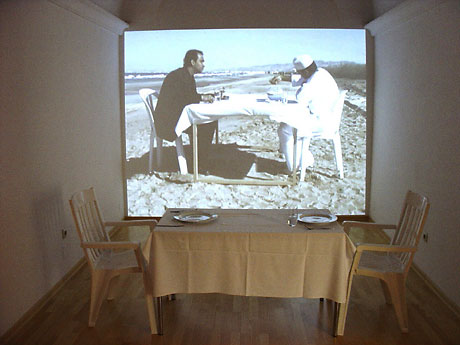
Ambiguity
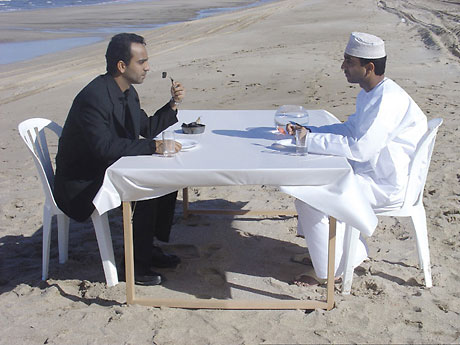
Ambiguity
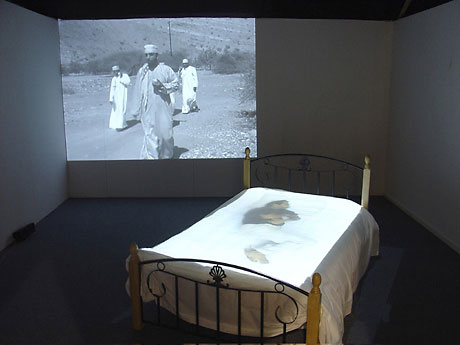
The Dream
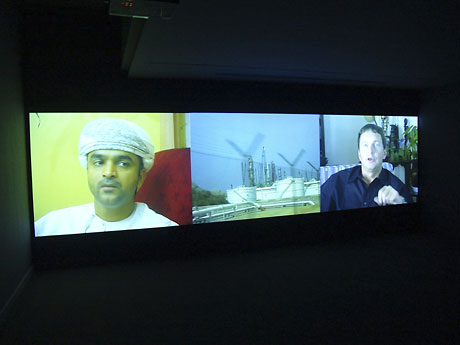
Oil Camp
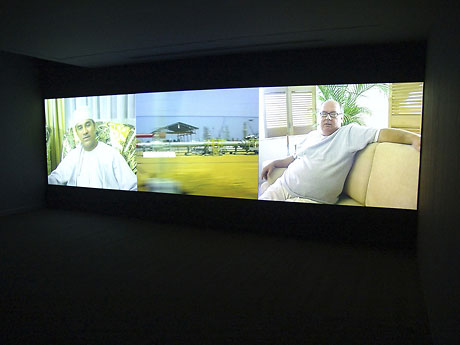
Oil Camp
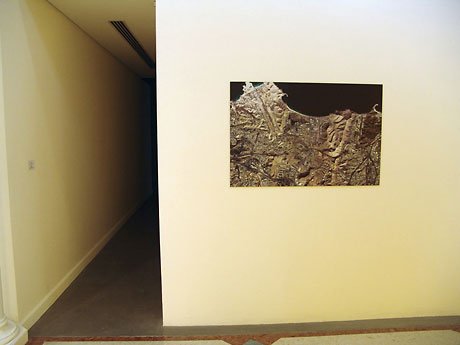
Oil Camp
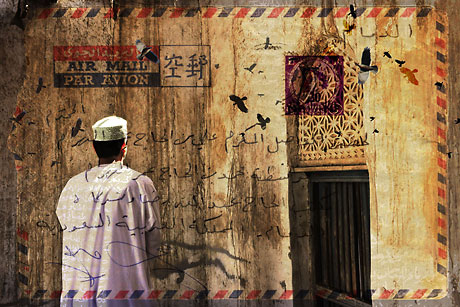
Call from my Grandfather
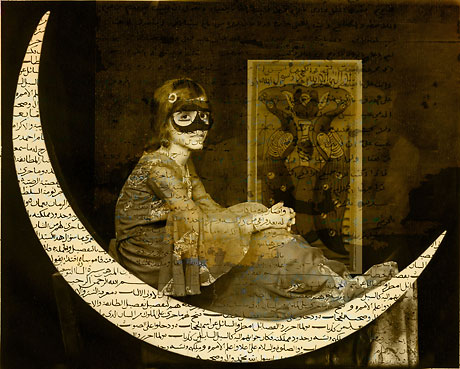
Zulika and the Moon
Omani Conceptual Avant-garde and the Circle: the Art of Hassan Meer
October 2009
Curator Aisha Stoby examines the work of Hassan Meer, based on an interview she conducted with the artist.
Hassan Meer, winner of several awards including the Golden Palm from the Second Gulf States Exhibition, is an acclaimed Omani artist who has also exhibited internationally. Born and raised in Muscat, he received his BA and MA in Fine Arts from the Savannah College of Art and Design, Georgia, USA. It was at this time that he began his explorations in the medium of video art. In the year 2000, Meer organized the first exhibition of the “Circle” series in Muscat, together with a select few of his pioneering peers. The main goal of the exhibition was to promote and foster experimental forms of artistic expression within Oman. The Circle series attracted international attention, launching Oman on to the global artistic stage. Still headed by Meer, the Circle has exhibited throughout the Gulf. Meer’s aim in taking these exhibitions abroad was to promote themes related to Omani culture, and to portray them through new media. The Circle has now expanded to include artists spanning the rest of the Gulf , Pakistan, Lebanon, South Africa, Austria, Japan, Morocco, and Germany.
Meer derived the concept of his “Circle” from the concept of the circle as the mother of being. The legendary Islamic mystic philosopher Ibn Arabi stated, “The universe in itself is similar to the central dot, the circle and what is there between them. The dot is God, the emptiness outside the circle is non-existence…and what is between the dot and the emptiness is the possibility of being”.
Meer’s work, especially in his paintings, revolves around a contemplation and search in the spiritual domain. It exhibits a fascination with the magic rituals bequeathed from ancient times, and the manner in which such rituals are still mysteriously rooted in society. These paintings relate to the Levant, its beliefs and legends. His art narrates his pondering upon, and questioning of, the mortality of man but it also examines other prevalent, local rituals. From the time of Meer’s childhood in Oman, he has not ceased to meditate upon the powerful effects that these legends have in controlling and directing the course of human life.
Overall, Meer’s work pertains primarily to identity and nationalism. He reconciles the amalgamation of traditional and national themes with cutting-edge contemporary media. In his case, conceptualism is a tool, in which he expresses elements of his rich cultural and historical heritage. Before the modern Omani Renaissance in the 1970s, Meer perceives the country as having been plunged into a medieval age. During the Renaissance, he recalls how his countrymen working abroad chose to return, instilled with new and foreign ideas and concepts. But the desire to relate such ideas to Omani subjects always prevailed in order to maintain an equilibrium of cultural authenticity. Both Meer’s paintings and photography manifest that linkage between the implementation of modernization and his indigenous culture.
One of the greatest challenges Meer initially faced in the exhibition of his work in Europe and the United States was the general public’s misunderstanding and wariness of installation work and video art, not least in the Middle East. However, after exhibiting at the Fifth International Cairo Biennale where only three artists including him presented video art which stormed its pavilions, greater awareness and appreciation has developed in the region and Meer can claim a major share of the credit for creating this trend. Since then, there has emerged a growing community of artists in Oman, as well as an audience eager to learn about the mediums of installation work and video art.
Meer’s work “New Identity” depicts his perspective on the hyper-acceleration of the techno-economic revolution in the last two decades and the manner in which he sees it trapping the populations it effects within the turmoil of globalisation. Meer’s vision is of transcontinental enterprises dominating mass human populations with the imposition of their concepts and lifestyle as the essential requirements for human survival in the modern era. The work also contends that globalisation is increasingly occupying the space for collective memory, by diluting aspects of national cultural heritage accumulated during the course of history and eliminating diversity as an enrichment of identity. In Meer’s view, the methods applied to impose globalisation vary from frank aggression on one side, (i.e. conflict, and the abuse of terms like freedom, justice, and democracy), to hidden and disguised aggression on the other side (i.e. filtered media etc). In fact, the artist himself does not oppose globalisation in principle, believing that, on a constructive, theoretical level, it could have been based on mutual benefits, legal diversity and equality amongst people. “New Identity” essentially manifests itself as a combative gesture against the notion or movement that aims to dilute and erase identity, culture and heritage.
In the same spirit as “New Identity”, Meer’s film “Ambiguity 2008” features two characters portrayed by the artist, with one wearing a dishdasha and the other attired in Western dress. Projected onto a large screen, the characters converse in front of an actual art installation comprising a table and chairs. Although the piece mirrors similar themes to those in “New Identity”, it goes further by resonating with issues signifying cultural paradoxes that force the individual to divide, conceal and “re-represent” various aspects of his identity based on his receiving audience and the space or domain in which he/she is present. On a metaphysical level, Meer perceives this paradox as a state of confusion between desire and action, based on possessing the tools of happiness whilst being uninterested, or unable, to employ them. He foresees these desires diminishing to an extent that exhausts the soul and the body while the tools of “desire/happiness” in life vanish.
“Oil Camp 2006”, previewed at the Sharjah Biennale, deals with environmental issues. Meer lived in an area near the oil camps in Oman and witnessed family members passing away while wondering if a correlation could be established between the oil camps and the sudden rise of cancer rates He interviewed two representatives who worked for the refinery, and the piece seeks to raise awareness of the need to document global change and its side effects.
In “The Dream”, Meer returns to his fixation on spirituality and the metaphysical dimension. The work features a screen displaying dream sequences and a projection of the artist on a bed. Only in the dream can the individual enjoy maximum freedom to interact with life and its implications with a degree of innocence. There, the individual becomes acquainted with its self, disengaging from the shackles of time and place, aware of the journey towards the unknown, from which they have originated. The individual inhabits a contrasting reality between beauty and terror, fiction and reality, and present and past.
Hassan Meer continues to function as an artist, curator, and writer within his concept of “The Circle”. He aspires to start a “Circle Foundation” and to establish a space dedicated to the Circle in the near future. Through his own work and through the Circle, Meer aims to encourage the young artistic generation of Oman including poets with whom he also engages. Meer and his fellow artists and poets are determined to pass on the tools they have gained in order to permit the general public in Oman to enjoy a broader and richer artistic dialogue and discourse.